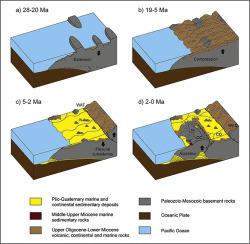当前位置:
X-MOL 学术
›
Earth Sci. Rev.
›
论文详情
Our official English website, www.x-mol.net, welcomes your feedback! (Note: you will need to create a separate account there.)
Tectonosedimentary evolution of the Coastal Cordillera and Central Depression of south-Central Chile (36°30′-42°S)
Earth-Science Reviews ( IF 12.1 ) Pub Date : 2021-02-01 , DOI: 10.1016/j.earscirev.2020.103465 A. Encinas , L. Sagripanti , M.P. Rodríguez , D. Orts , A. Anavalón , P. Giroux , J. Otero , A. Echaurren , P. Zambrano , V. Valencia
Earth-Science Reviews ( IF 12.1 ) Pub Date : 2021-02-01 , DOI: 10.1016/j.earscirev.2020.103465 A. Encinas , L. Sagripanti , M.P. Rodríguez , D. Orts , A. Anavalón , P. Giroux , J. Otero , A. Echaurren , P. Zambrano , V. Valencia

|
Abstract The forearc of south-central Chile (36°30′-42°S) is characterized by the presence of a Coastal Cordillera and a low lying area known as the Central Depression. The origin of these morphostructural units has been largely debated. They have been ascribed to different ages between the Cretaceous and the Pliocene, and tectonic causes that involve extensional or contractional deformation and have been related to Andean evolution or accretionary processes in the forearc. To investigate the geologic evolution of the Coastal Cordillera and Central Depression in the cited area, we based on stratigraphy, sedimentology, geochronology (U Pb, LA-ICP-MS), structural geology, and geomorphology. Our studies, which are based on our own data and a thorough bibliographic review, indicate the following sequence of events in the tectono-sedimentary evolution of the forearc of south-central Chile during the late Cenozoic. The area was subjected to extensional tectonics caused by slab rollback during the Oligocene-early Miocene, resulting in the genesis of a series of basins filled with volcanic, continental, and marine deposits that extended from the present Chilean coast to the retroac. The extensional basins were tectonically inverted during the late Early-Late Miocene, and most of the forearc became a positive relief that was subjected to fluvial erosion. The West Andean Thrust, a major reverse west verging fault in the limit between the Central Depression and the Andean Cordillera, caused significant uplift of the western flank of the Andes. This triggered flexural subsidence and the accumulation of coarse-grained deposits in the forearc during the Pliocene-Pleistocene. The sudden increase of sediment flux to the trench during this period caused a change from non-accretion or subduction erosion to accretion in the margin of south-central Chile. Progressive growth of the accretionary wedge gave birth to a forearc high, the Coastal Cordillera, which was uplifted in the last 2 Ma. Some forearc areas placed above subducted oceanic fracture zones did not experience uplift during this period due to the significant transport of fluid that inhibited the deformation of the accretionary wedge. Our studies show that the late Cenozoic tectono-sedimentary evolution of the forearc in the study area is complex and involves different processes related to Andean evolution in the first stage and accretionary processes acting exclusively in the forearc in a second stage. The Coastal Cordillera and the Central Depression of south-central Chile were developed in the last 2 Ma and are much younger than classically considered.
中文翻译:

智利中南部海岸山脉和中央坳陷的构造沉积演化 (36°30′-42°S)
摘要 智利中南部(36°30′-42°S)前弧的特征是存在沿海山脉和被称为中央凹陷的低洼区。这些形态结构单元的起源一直存在很大争议。它们被归因于白垩纪和上新世之间的不同时代,以及涉及伸展或收缩变形的构造原因,并与安第斯演化或弧前的增生过程有关。为了研究引用地区沿海山脉和中央坳陷的地质演化,我们基于地层学、沉积学、地质年代学 (U Pb, LA-ICP-MS)、构造地质学和地貌学。我们的研究基于我们自己的数据和彻底的书目审查,表明了晚新生代智利中南部弧前构造-沉积演化的下列事件序列。该地区在渐新世 - 早中新世期间受到板块回滚引起的伸展构造的影响,导致一系列充满火山、大陆和海洋沉积物的盆地形成,这些盆地从现在的智利海岸延伸到后弧。拉张盆地在早中新世晚期发生构造倒置,大部分前弧变为正地貌,受到河流侵蚀。西安第斯逆冲断层是中央坳陷和安第斯山脉之间的一个主要的反向西濒断层,导致安第斯山脉西侧的显着隆升。在上新世-更新世期间,这引发了弯曲下沉和前弧中粗粒沉积物的积累。在此期间,流入海沟的泥沙通量突然增加,导致智利中南部边缘从非吸积或俯冲侵蚀转变为吸积。增生楔的逐步增长产生了前弧高,海岸山脉,在过去的 2 Ma 中被抬升。由于流体的大量输送抑制了增生楔的变形,一些位于俯冲海洋断裂带上方的前弧区域在此期间没有经历抬升。我们的研究表明,研究区晚新生代弧前构造-沉积演化是复杂的,涉及第一阶段与安第斯演化相关的不同过程,以及第二阶段仅作用于弧前的增生过程。智利中南部的沿海山脉和中央坳陷是在过去的 2 Ma 中开发的,比经典认为的要年轻得多。
更新日期:2021-02-01
中文翻译:

智利中南部海岸山脉和中央坳陷的构造沉积演化 (36°30′-42°S)
摘要 智利中南部(36°30′-42°S)前弧的特征是存在沿海山脉和被称为中央凹陷的低洼区。这些形态结构单元的起源一直存在很大争议。它们被归因于白垩纪和上新世之间的不同时代,以及涉及伸展或收缩变形的构造原因,并与安第斯演化或弧前的增生过程有关。为了研究引用地区沿海山脉和中央坳陷的地质演化,我们基于地层学、沉积学、地质年代学 (U Pb, LA-ICP-MS)、构造地质学和地貌学。我们的研究基于我们自己的数据和彻底的书目审查,表明了晚新生代智利中南部弧前构造-沉积演化的下列事件序列。该地区在渐新世 - 早中新世期间受到板块回滚引起的伸展构造的影响,导致一系列充满火山、大陆和海洋沉积物的盆地形成,这些盆地从现在的智利海岸延伸到后弧。拉张盆地在早中新世晚期发生构造倒置,大部分前弧变为正地貌,受到河流侵蚀。西安第斯逆冲断层是中央坳陷和安第斯山脉之间的一个主要的反向西濒断层,导致安第斯山脉西侧的显着隆升。在上新世-更新世期间,这引发了弯曲下沉和前弧中粗粒沉积物的积累。在此期间,流入海沟的泥沙通量突然增加,导致智利中南部边缘从非吸积或俯冲侵蚀转变为吸积。增生楔的逐步增长产生了前弧高,海岸山脉,在过去的 2 Ma 中被抬升。由于流体的大量输送抑制了增生楔的变形,一些位于俯冲海洋断裂带上方的前弧区域在此期间没有经历抬升。我们的研究表明,研究区晚新生代弧前构造-沉积演化是复杂的,涉及第一阶段与安第斯演化相关的不同过程,以及第二阶段仅作用于弧前的增生过程。智利中南部的沿海山脉和中央坳陷是在过去的 2 Ma 中开发的,比经典认为的要年轻得多。


























 京公网安备 11010802027423号
京公网安备 11010802027423号